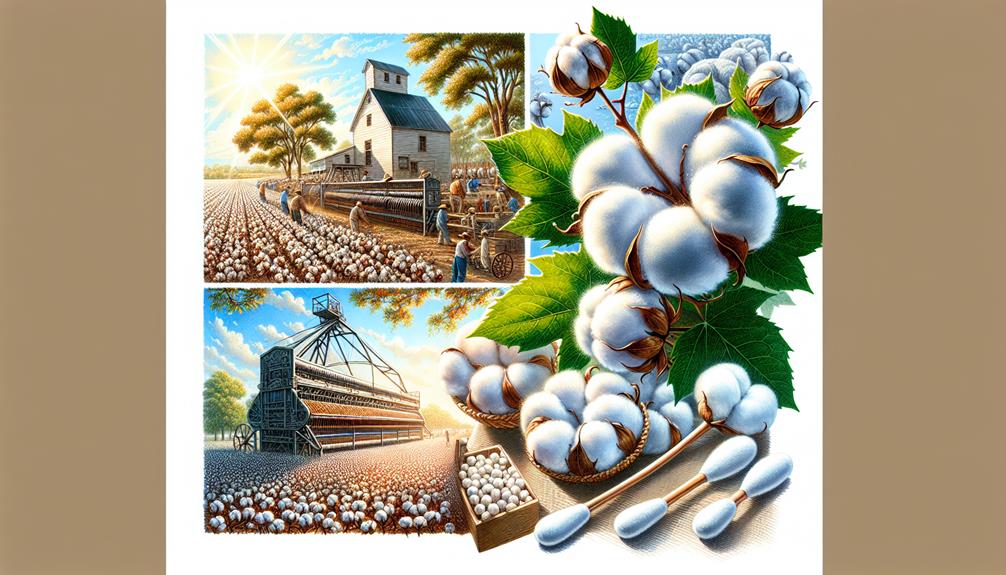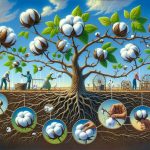Cotton seeds found in Peru date back to 450 BC. The cotton gin changed fiber separation. Cotton grows for fibers, animal feed, and oil. After harvest, cotton stalks return to the soil. Cotton's journey from Peru to a global commodity showcases resilience. Discover more intriguing facts about this versatile and historical fabric.
Table of Contents
Key Takeaways
- Cotton seeds discovered in Peru date back to 450 BC.
- Cotton fibers can absorb up to 27 times their weight in water.
- The cotton gin revolutionized fiber separation.
- Cotton is grown in ancient civilizations like India, China, and Egypt.
- Cotton is a primary material in garments for its softness and breathability.
History of Cotton
Dating back to 450 BC, cotton seeds discovered in Peru provide a fascinating glimpse into the ancient history of this versatile plant. The utilization of cotton dates back centuries, with the cotton gin's invention revolutionizing production by efficiently separating fibers from seeds. Primarily grown for its fibers, cotton seeds are also used for animal feed and oil production. After harvesting, cotton stalks are tilled back into the soil, ensuring no waste in plant utilization.
The ancient roots of cotton highlight its enduring significance and impact on human civilization. From its humble beginnings to the modern cotton industry, the history of this plant is rich and storied. Understanding how cotton has been cultivated, harvested, and processed throughout history gives us a deeper appreciation for its importance in our lives today. The journey of cotton from a seed in ancient Peru to a global commodity showcases the resilience and adaptability of this remarkable plant.
Cotton Production Statistics
Cotton production statistics reveal essential insights into the industry's scale and impact on various regions. The U.S. produced almost 20 million bales of cotton from August 2019 to July 2020, highlighting its significant contribution to the global cotton market. Texas plays a critical role, accounting for nearly 40% of cotton production in the U.S., showcasing its dominance in the industry. Surprisingly, Kansas experienced an 18% increase in planted acres for cotton from 2017 to 2021, demonstrating a growing interest in cotton cultivation in the region.
Moreover, the history of cotton cultivation dates back thousands of years to ancient civilizations like India, China, and Egypt, underscoring its enduring importance and widespread cultivation. Additionally, cotton bolls, which are technically fruits, are utilized to produce cottonseed oil for cooking and various other products, showcasing the versatility of this crop. Through these statistics, we gain a deeper appreciation for the scale, diversity, and historical significance of cotton production in different regions.
Unique Qualities of Cotton
In exploring the remarkable characteristics of cotton, it becomes clear why this natural fiber stands out in various industries for its exceptional properties. Cotton fibers possess a unique ability to absorb up to 27 times their weight in water, making them highly absorbent. This quality makes cotton ideal for products like towels and clothing that require moisture-wicking capabilities. Additionally, cotton is celebrated for its softness, being a completely natural fabric that feels gentle and comfortable against the skin. The protective boll that houses cotton fibers guarantees their purity and integrity, making cotton a sought-after material in the textile industry.
One fascinating aspect of cotton is that it becomes stronger when wet, a feature that distinguishes it from other textiles. This strength makes cotton perfect for items like wet wipes and other absorbent products that need durability in moist conditions. Moreover, cottonseed oil, derived from the cotton bolls, is a valuable commodity used in cooking. However, it's crucial to note that cottonseed oil shouldn't be consumed raw due to certain compounds present in it.
Global Impact of Cotton
The global impact of cotton extends far beyond its cultivation and trade, influencing economies and industries worldwide. It's interesting to note that the Better Cotton Initiative plays a significant role in promoting sustainable practices to lessen the environmental footprint of cotton cultivation. Countries such as India, China, and the U.S. are pivotal in cotton production, with substantial economic implications. Additionally, cotton exports are essential for nations like Benin, Greece, and Mali, contributing significantly to their economies.
An interesting fact is that China stands out as the largest consumer of cotton globally, closely followed by India and Pakistan, underscoring the immense global demand for cotton products. As cotton consumption continues to rise steadily, its versatility and importance in various industries worldwide become increasingly evident. The preference for natural fibers like cotton not only influences fashion and textiles but also impacts sectors such as agriculture, manufacturing, and trade on a global scale.
Diverse Applications of Cotton
With its remarkable versatility and widespread popularity, this natural fiber finds its way into numerous everyday items, showcasing the diverse applications of this beloved material. When it comes to the diverse applications of cotton, one can see its presence in various essential products. Below is a table highlighting some of the common uses of cotton:
| Application | Description |
|---|---|
| Clothing | Cotton is a primary material in garments due to its softness and breathability. |
| Bed Sheets | Soft and comfortable bed sheets are often made from cotton fibers. |
| Towels | Highly absorbent towels are commonly crafted from cotton for quick drying. |
| First Light Bulb | Cotton played an important role in Thomas Edison's first successful light bulb. |
Cotton's versatility has been utilized for thousands of years, with its short fibers making it ideal for various products. From the United States to across the globe, cotton comes in handy for an array of applications, showcasing its importance in our daily lives.
Frequently Asked Questions
What Are 5 Common Uses for Cotton?
Cotton serves as a versatile material in my everyday life. I rely on its softness and breathability in clothing, bedding, and towels. It's also essential in hygiene products and cooking oil. Its durability makes it a staple in textiles.
What Are Some Facts About Cotton for Kids?
Cotton is a fascinating plant that kids love to learn about. It grows in warm climates, has fluffy bolls with fibers that make soft clothes, and has been used for thousands of years.
What Are 5 Characteristics of Cotton?
Cotton, with its natural fibers, is soft, breathable, and absorbent. It's hypoallergenic, durable, and available in various colors. These characteristics make it perfect for clothing, towels, and other products, providing comfort and versatility.
What Is Special About Cotton?
Cotton, a natural fabric, stands out for its softness, breathability, and versatility. It has a rich history dating back thousands of years and remains a key player in textiles, offering comfort and hypoallergenic properties.
- Why Is Red Velvet Not Red? - April 25, 2024
- How Do You Describe Velvet Fabric? - April 25, 2024
- How Strong Is Velvet? - April 25, 2024








